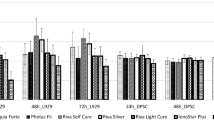Abstract
In vitro cytotoxicity test is an initial step to identify the harmful effects of new dental materials. Aim of this study was to develop a stable human cell line derived from normal gingival fibroblasts (hNOF) and to assess its feasibility in in vitro cytotoxicity testing. Immortalized human gingival fibroblasts (hTERT-hNOF) were successfully established with human telomerase reverse transcriptase gene transfection, preserving its phenotypical characteristics, replicative potential and biological properties. Utilizing standard cytotoxicity test modeling and dental materials, hTERT-hNOF were evaluated for their feasibility in cytotoxicity testing, compared with hNOF and L929 cells. Similar pattern of cytotoxic response was observed among hNOF, hTERT-hNOF and L929 cells. Cytotoxicity response of hTERT-hNOF was significantly similar to hNOF, moreover hTERT-hNOF and hNOF were found to be more sensitive towards the tested dental materials compared to L929 cells. This study suggested that hTERT-hNOF is an effective cytotoxic test model for dental materials.




Similar content being viewed by others
References
International Standards Organization. ISO10993-5:biological eveluation of medical devices- part 5.Geneva:ISO;1999.
Elshahawy WM, Watanabe I, Kramer P. In vitro cytotoxicity evaluation of elemental ions released from different prosthodontic materials. Dent Mater. 2009;25:1551–6.
Williams DF. On the mechanisms of biocompatibility. Biomaterials. 2008;29:2941–53.
Chaves Cde A, Machado AL, Carlos IZ, et al. Cytotoxicity of monomers, plasticizer and degradation by-products released from dental hard chairside reline resins. Dent Mater. 2010;26:1017–23.
Schmid-Schwap M, Franz A, Konig F, et al. Cytotoxicity of four categories of dental cements. Dent Mater. 2009;25:360–8.
Meric G, Dahl JE, Ruyter IE. Cytotoxicity of silica-glass fiber reinforced composites. Dent Mater. 2008;24:1201–6.
Schedle A, Samorapoompichit P, Rausch-Fan XH, et al. Response of L-929 fibroblasts, human gingival fibroblasts, and human tissue mast cells to various metal cations. J Dent Res. 1995;74:1513–20.
Gregson KS, Terrence O’Neill J, Platt JA, et al. In vitro induction of hydrolytic activity in human gingival and pulp fibroblasts by triethylene glycol dimethacrylate and monocyte chemotatic protein-1. Dent Mater. 2008;24:1461–7.
Urcan E, Haertel U, Styllou M, et al. Real-time xCELLigence impedance analysis of the cytotoxicity of dental composite components on human gingival fibroblasts. Dent Mater. 2010;26:51–8.
Volk J, Ziemann C, Leyhausen G, et al. Non-irradiated campherquinone induces DNA damage in human gingival fibroblasts. Dent Mater. 2009;25:1556–63.
Gregson KS, Jack Windsor L, Platt JA. Biodegradation of a dental resin material by fibroblast conditioned media. Dent Mater. 2009;25:1358–62.
Sigusch BW, Pflaum T, Volpel A, et al. The influence of various light curing units on the cytotoxicity of dental adhesives. Dent Mater. 2009;25:1446–52.
Chang MC, Lin LD, Chen YJ, et al. Comparative cytotoxicity of five root canal sealers on cultured human periodontal ligament fibroblasts. Int Endod J. 2010;43:251–7.
Brunot C, Grosgogeat B, Picart C, et al. Response of fibroblast activity and polyelectrolyte multilayer films coating titanium. Dent Mater. 2008;24:1025–35.
Hayflick L, Moorhead PS. The serial cultivation of human diploid cell strains. Exp Cell Res. 1961;25:585–621.
Shelton DN, Chang E, Whittier PS, et al. Microarray analysis of replicative senescence. Curr Biol. 1999;9:939–45.
Enoch S, Wall I, Peake M, et al. Increased oral fibroblast lifespan is telomerase-independent. J Dent Res. 2009;88:916–21.
Kamata N, Fujimoto R, Tomonari M, et al. Immortalization of human dental papilla, dental pulp, periodontal ligament cells and gingival fibroblasts by telomerase reverse transcriptase. J Oral Pathol Med. 2004;33:417–23.
Morales CP, Holt SE, Ouellette M, et al. Absence of cancer-associated changes in human fibroblasts immortalized with telomerase. Nat Genet. 1999;21:115–8.
Counter CM, Avilion AA, LeFeuvre CE, et al. Telomere shortening associated with chromosome instability is arrested in immortal cells which express telomerase activity. EMBO J. 1992;11:1921–9.
Greider CW. Telomere length regulation. Annu Rev Biochem. 1996;65:337–65.
Robertson DM, Li L, Fisher S, et al. Characterization of growth and differentiation in a telomerase-immortalized human corneal epithelial cell line. Invest Ophthalmol Vis Sci. 2005;46:470–8.
Wang BL, Li L, Zheng YF. In vitro cytotoxicity and hemocompatibility studies of Ti-Nb, Ti-Nb-Zr and Ti-Nb-Hf biomedical shape memory alloys. Biomed Mater. 2010;5:044102.
Badr AE. Marginal adaptation and cytotoxicity of bone cement compared with amalgam and mineral trioxide aggregate as root-end filling materials. J Endod. 2010;36:1056–60.
Dimri GP, Lee X, Basile G, et al. A biomarker that identifies senescent human cells in culture and in aging skin in vivo. Proc Natl Acad Sci U S A. 1995;92:9363–7.
Jeng JH, Hahn LJ, Lin BR, et al. Effects of areca nut, inflorescence piper betle extracts and arecoline on cytotoxicity, total and unscheduled DNA synthesis in cultured gingival keratinocytes. J Oral Pathol Med. 1999;28:64–71.
Kim B, Ejaz S, Chekarova I, et al. Cytotoxicity of fumonisin B(1) in spheroid and monolayer cultures of rat hepatocytes. Drug Chem Toxicol. 2008;31:339–52.
Samuelsen JT, Holme JA, Becher R, et al. HEMA reduces cell proliferation and induces apoptosis in vitro. Dent Mater. 2008;24:134–40.
Kong N, Jiang T, Zhou Z, et al. Cytotoxicity of polymerized resin cements on human dental pulp cells in vitro. Dent Mater. 2009;25:1371–5.
Dean DM, Morgan JR. Cytoskeletal-mediated tension modulates the directed self-assembly of microtissues. Tissue Eng A. 2008;14:1989–97.
Issa Y, Brunton P, Waters CM, et al. Cytotoxicity of metal ions to human oligodendroglial cells and human gingival fibroblasts assessed by mitochondrial dehydrogenase activity. Dent Mater. 2008;24:281–7.
Acknowledgments
This study was supported by the Priority Research Centers Program through the National Research Foundation of South Korea (NRF) funded by the Ministry of Education, Science and Technology (2009-0094028) and the NRF (R13-2003-013-04001-0). The authors also would like to extend sincere thanks to Professor Darren Williams, Professor Da-Woon Jung and N. Tyagi of Department of Life Science, Gwangju Institute of Science and Technology, Korea, for critical reading of the manuscript and Professor Ki Yeol Kim of the Oral Cancer Research Institute, Yonsei University College of Dentistry, for the support in statistical data analysis.
Author information
Authors and Affiliations
Corresponding author
Additional information
An erratum to this article can be found at http://dx.doi.org/10.1007/s10856-012-4589-3.
Rights and permissions
About this article
Cite this article
Illeperuma, R.P., Park, Y.J., Kim, J.M. et al. Immortalized gingival fibroblasts as a cytotoxicity test model for dental materials. J Mater Sci: Mater Med 23, 753–762 (2012). https://doi.org/10.1007/s10856-011-4473-6
Received:
Accepted:
Published:
Issue Date:
DOI: https://doi.org/10.1007/s10856-011-4473-6




